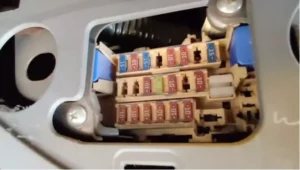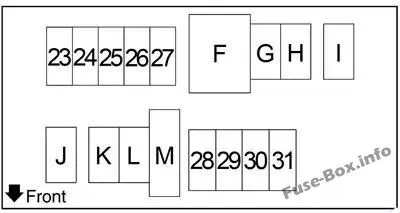
The Nissan Versa Fuse Box Diagram provides circuit details and locations of fuses for the 2011-2020 Nissan Versa, also known as the Nissan Sunny and Nissan Latio in certain regions. The fuse box is located on the driver’s side of the instrument panel, behind the cover. The video tutorial shows the passenger and engine (power distribution box) fuse box diagrams. The engine compartment contains fuses for headlights, tail lamps, air conditioner relay, fuel pump relay, brake control system, throttle control motor relay, and more. The additional fuse box has fuses for charging system, horn, CVT control system, base audio system, front fog lamp, and more. The fusible link box contains fuses for generator, ignition relay, accessory 1 relay, headlamp high relay, and more. The FAQ section provides answers to common questions about the Nissan Versa fuse box diagram, including how to replace a blown fuse, how to check if the alternator is bad, and where to find the dashboard fuse. This information is essential for Nissan Versa owners who need to troubleshoot electrical issues or replace fuses.
Nissan Versa Fuse Box Diagram
Nissan Versa Fuse Box Diagram
Fuse box diagram and location for the 2011-2020 Nissan Versa.
In this video, we show the passenger and engine (power distribution box) fuse box diagrams on a 2011-2020 Nissan Versa. This model is also known as the Nissan Sunny and Nissan Latio, depending on where you are located. We hope this video is helpful, thanks for watching!
Nissan Versa Fuse Box Location / Diagram
The fuse box is located on the driver’s side of the instrument panel, behind the cover.


Fuse Diagrams





Engine compartment

| № | Amp | Circuit |
|---|---|---|
| 34 | 10 | Headlights (High Beam) |
| 35 | 10 | Headlights (High Beam) |
| 37 | 10 | Tail Lamp Relay Parking Lamps License Plate Lamps Headlamp Aiming Motor – Manual Daytime Light System |
| 38 | – | – |
| 39 | 30 | Front Wiper And Washer System |
| 40 | 15 | Headlights (Low Beam) |
| 41 | 15 | Headlights (Low Beam) |
| 42 | 10 | Air Conditioner Relay |
| 48 | 15 | Fuel Pump Relay |
| 49 | 10 | Back-Up Lamp BCM (Body Control Module) CVT Control System Engine Control System Intelligent Key System/Engine Start Function NVIS Power Distribution System Navigation System Starting System |
| 50 | 10 | Brake Control System |
| 51 | 10 | Engine Control System |
| 52 | 15 | Throttle Control Motor Relay |
| 53 | 20 | ECM Relay Engine Control System NVIS |
| 54 | 15 | Engine Control System |
| 55 | 10 | Engine Control System |
Additional Fuse Box

| № | Amp | Circuit |
|---|---|---|
| 23 | – | – |
| 24 | 10 | Charging System Horn Intelligent Key System Vehicle Security System |
| 25 | 10 | CVT Control System |
| 26 | – | – |
| 27 | – | – |
| 28 | – | – |
| 29 | 15 | Base Audio System |
| 29 | 20 | Except Base Audio: Display Audio System, Navigation System |
| 30 | 10 | BCM (Body Control Module) Brake Control System Engine Control System Intelligent Key System/Engine Start Function NVIS Power Distribution System Stop Lamp Warning Chime System |
| 31 | 15 | Front Fog Lamp |
| F | 40 | M/T: Cooling Fan Low Relay, Cooling Fan High Relay |
| F | 50 | CVT: Cooling Fan Low Relay, Cooling Fan High Relay |
| G | 40 | BCM (Body Control Module) Daytime Light System Front Fog Lamp Front Wiper And Washer System Headlamp Headlight Aiming System – Manual Illumination Interior Room Lamp Intelligent Key System/Engine Start Function NVIS, Parking Lamps License Plate And Tail Lamps Power Window System Power Door Lock System Remote Keyless Entry System Rear Window Defogger Rear Wiper Washer System Turn Signal And Hazard Warning Lamps Vehicle Security System Warning Chime System |
| H | 40 | Starting System Ignition Relay (“3”, “5”, “6”, “7” fuses) BCM (Body Control Module) Intelligent Key System/Engine Start Function NVIS “18” fuse |
| I | 40 | – |
| J | 60 | Electronically Controlled Power Steering System |
| K | – | – |
| L | 30 | Brake Control System |
| M | 30 | Brake Control System |
Fusible Link Box

| № | Amp | Circuit |
|---|---|---|
| A | 120 | Generator, “D”, “E” fuses |
| B | 60 | Ignition 1 Relay (Front Wiper High Relay, Cooling Fan High Relay, Cooling Fan Low Relay, A/C Relay, “48” fuse), “52”, “53”fuses |
| C | 80 | Accessory 1 Relay (“15”, “17” fuses), Blower Relay (“20”, “21”, “22” fuses), “8”, “10”, “11”, “12” fuses |
| D | 100 | “24”, “25”, “29”, “30”, “31”, “F”, “G”, “H”, “J”, “L”, “M” fuses |
| E | 80 | Headlamp High Relay (“34”, “35” fuses), Headlamp Low Relay (“40”, “41” fuses), “37”, “39”, “42” fuses |
FAQS
Where are the fuses in a Nissan Versa?
The fuse box is located on the driver’s side of the instrument panel, behind the cover.
How do I replace the fuse box cover?
The fuse box cover is held in place by two screws. You can remove the screws with a T-20 Torx screwdriver.
How do I access the fuses?
The cover is held in place by two screws. Remove the screws and lift up the cover to access the fuses.
How do I replace a blown fuse?
With the fuse box cover removed, you can easily access and replace a blown fuse. Just be sure to use the correct amperage replacement.
How do you tell if a fuse is blown?
Remove the fuse from its holder. In some cases you may need a small screwdriver to unscrew the fuse holder cap. Look at the fuse wire. If there is a visible gap in the wire or a dark or metallic smear inside the glass then the fuse is blown and needs to be replaced.
How do you change a fuse in a Nissan Versa?
Remove Cover – Locate engine fuse box and remove cover.
Locate Bad Fuse – Find the fuse that is tied to the bad component.
Remove Fuse – Take out the fuse in question and assess if blown.
Replace Cover – Secure the cover and test component.
More Info. –
Can a bad fuse drain a car battery?
3. Electrical Glitches. Electrical glitches in your car and car battery may be caused by factors such as poor installation, faulty fuses, and flawed wiring. These electrical glitches can result in the normal and expected parasitic drains on your car battery becoming excessive and drain the battery when the car is .
Where is the driver side fuse?
The interior fuse box is on the driver’s lower left side. To remove the fuse box lid, pull it toward you and take it out of its hinges. The under-hood fuse box is located near the back of the engine compart- ment on the driver’s side.
Should you disconnect the battery when replacing fuses?
Before you start working on any automotive project, it’s important that you turn off the engine and disconnect the battery, especially before doing any electrical work. Any misstep with automotive wiring while the battery is hooked up could cause further damage and potentially give you an unpleasant zap.
Where is the second fuse panel?
The interior fuse box is underneath the steering column. The under-hood fuse box is in the engine compartment next to the battery.
How do you check if your alternator is bad?
First, open the hood and start the car. While the engine is running, remove the negative cable from the battery. If the vehicle stalls or dies, the alternator is likely bad. This happens because the alternator is not generating enough electricity to keep the engine running on its own
How long do fuses last in a car?
If one bulb is working but not the other, the problem is not the fuse. Fuses should last for years. If you’re having problems with your car’s lightbulb fuses blowing frequently, there’s definitely an electrical problem present and you should have it inspected and diagnosed immediately by a professional mechanic.
Where is the dashboard fuse located?
The instrument panel fuse box is usually located inside the vehicle, and usually on the driver’s side. There should be a diagram inside the fuse box (or in the owner’s manual) that shows you what each fuse powers.
Where is the fuse or relay located?
The fuses and relays are usually identified on the inside of the power center cover.
What causes dash lights to not work?
If the dashboard lights aren’t working at all, a blown fuse may be the culprit. It’s relatively easy to remove and replace a fuse that has been damaged; however, if the fuse blows again, it could be indicative of a deeper electrical problem that a professional will need to address
Why is my dash panel not working?
If the dashboard isn’t lighting up at all, your car might have blown a fuse. Removing the old fuse and replacing it should get the lights working again. While the new fuse may do the trick, it could also indicate a deeper electrical problem.
Is a fuse and relay the same thing?
A fuse is a one time protection device that can interrupt a circuit. A relay is a device that is used to connect or interrupt the circuit.
